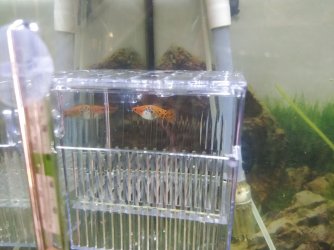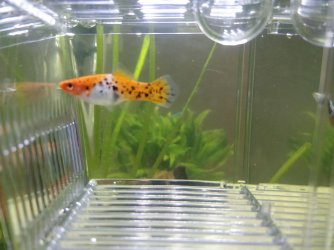Hi and welcome to the forum

Take her out of the breeding trap. They are awful things that stress the female fish and either cause the babies to be born prematurely and die, or the females turn around and eat the babies straight after giving birth.
The best thing to do with female livebearers is have lots of plants in the tank and feed them well. The best plant to use is Water Sprite (Ceratopteris thalictroides/ cornuta). This is a floating plant that can also be planted in the gravel, and it provides a great hiding place for baby fish and for the mothers to hide in when in labour.
Livebearers carry the babies for about 1 month and I would say your female is about half way thru her pregnancy.
--------------------------
Onto a different subject, how long has the tank been set up for?
Was the aquarium cycled for a month before you added fish?
If not, you are probably going to get ammonia and nitrite readings over the next month and these chemicals can kill the fish. If you don't have an ammonia, nitrite, nitrate & pH test kit, you should probably look into buying one. Get a liquid test kit not the paper strip test kit, and check the expiry date on the kit. Keep the test kit in a cool dry place (I kept mine in a plastic container with lid, on the bottom shelf in the fridge).
*NB* Make sure children and animals can't get to the test kits because they have poisonous chemicals in them.
After testing the water, rinse the test phials out with tap water and wash your hands with soapy water.
If you can't afford the test kits, take a glass full of tank water to the local pet shop and ask them if they can test it for you. Some shops do this for free, but others charge a small fee to cover the cost of the test kits they use. When they do the test, write the results down and post them here. The results will be something like: Ammonia 0.25, Nitrite 0.5, Nitrate 25, pH 7.4.
Monitor the ammonia and nitrite levels over the next month and if you get any ammonia or nitrite levels in the tank water, do a 75% water change and gravel clean the substrate. Use a basic model gravel cleaner like the one in the following link to clean the gunk out of the gravel.
https://www.about-goldfish.com/aquarium-cleaning.html
If the tank is cycling (developing filter bacteria), you should only feed the fish once every second day and do a 75% water change and complete gravel clean 4-8 hours after feeding the fish.
--------------------------
When you do water changes, only use a bucket that is specifically for the fish. Do not use any buckets that have been used for cleaning or anything else. If you can, go and buy a couple of new buckets and wash them out with soapy water, then rinse well with fresh water. Use a soap that does not have perfume in. Once you have washed and rinsed the buckets, use a permanent marker and write "FISH ONLY" on them and don't let anyone else use them for anything except the fish.
You can keep nets and gravel cleaners in these fish only buckets and keep the bucket near the tank.
If you use a sponge to clean the inside of the tank, make sure it does not have any additives. Some brands of sponges used in the kitchen, have chemicals and soaps added to stop mould and other things growing in them. DO NOT use these types of sponges. Check the packaging and see if anything has been added to the sponge. Do not use any sponge with any chemicals added to them. Cheap sponges from a $2 shop are generally free of chemicals and usually a safer choice. Wash them with warm soapy water before using them to get rid of any dye or dust, and rinse well before squeezing them out and put them in your fish bucket.
When working on the tank or feeding the fish, make sure you do not have any creams, perfume, deodorant, hair spray, oil, grease or anything else on your hands. These can wash off your skin and poison the fish.
Do not use perfume, hair spray, deodorant, bug spray, air fresheners, paint, smoke or do anything else in the room that produces fumes. These can settle on the surface of the water and poison the fish or cause them to suffocate.
--------------------------
If your fish ever look unwell, off colour or are acting funny, test the water for ammonia, nitrite, nitrate & pH and write the results down, then do a 75% water change and complete gravel clean. Then take some pictures of the fish and post them on here with the water test results, asap. Start a new thread and ask for help.
Most fish health issues are directly linked to poor water quality. The first thing to do in any fish emergency is a water change. If in doubt, water change it out.
And if you have any questions about fish, just ask.






